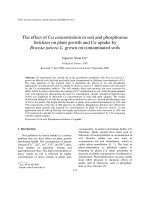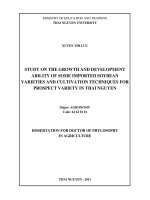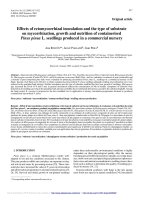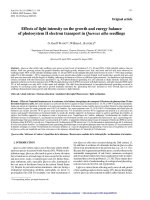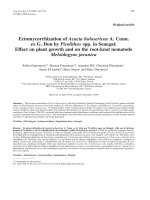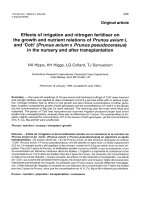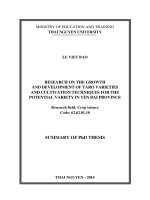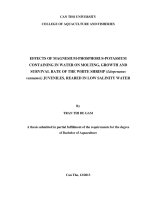The influence of bulb storage regimes on the growth and flowering of Hippeastrum (Hippeastrum hybridum Hort.)
Bạn đang xem bản rút gọn của tài liệu. Xem và tải ngay bản đầy đủ của tài liệu tại đây (508.14 KB, 7 trang )
Vietnam Journal
of Agricultural
Sciences
ISSN 2588-1299
VJAS 2018; 1(2): 127-133
/>
The Influence of Bulb Storage Regimes on
the Growth and Flowering of Hippeastrum
(Hippeastrum hybridum Hort.)
Pham Thi Huyen Trang1, Dinh Van Nam1, Trinh Thi Thanh Nga1,
Phung Thi Thu Ha1, Nguyen Thi Thuy Hanh2 and Nguyen Hanh Hoa1
1
Faculty of Agronomy, Vietnam National University of Agriculture, Hanoi 131000,
Vietnam
2
Faculty of Biotechnology, Vietnam National University of Agriculture, Hanoi 131000,
Vietnam
Abstract
Hippeastrum hybridum cultivar ‘Cam Tu’ bulbs were subjected to
ten different treatment regimens to evaluate the effect of
temperature (4°C or 25°C), duration (4, 6, or 8 weeks), and
wrapping materials (coir fiber or newspaper) on their growth and
flowering. The data revealed that the storage treatments had
significant effects on several growth and flowering characteristics of
H. hybridum cv. ‘Cam Tu’. In terms of vegetative characteristics,
bulbs stored at 4°C with coir fiber wrapping for 6 weeks (T9) had
the largest leaf size (a length of 39.46 cm, a width of 4.39 cm), the
longest flower scape (48.64 cm in length), and the longest pedicel
(4.75 cm in length). Bulbs of the T9 treatment also showed the
shortest time to flower bud emergence (62.24 days) and first flower
opening (80.43 days), and the date of 70% first flower fully opening
was January 19, 2018. Both of the two thermal treatment regimens
shortened flowering time (80.43-103.16 days) compared to the
control (132.46 days). However, the number of bulblets per plant,
number of leaves per plant, number of florets per scape, floret
diameter, longevity of a flower, and longevity of a flower scape
were not statistically impacted by the treatments.
Keywords
Hippeastrum hybridum,
materials, flowering time
Amaryllis,
temperature,
wrapping
Introduction
Received: March 8, 2017
Accepted: September 7, 2018
Correspondence to
/>
Hippeastrum Herb. (Amaryllidaceae) is an important genus
comprised of about 60 to 70 species and more than 300 cultivars
(Liberty, 1976; Read, 2004). Amaryllis plants (belonging to the
genus Hippeastrum) are primarily indigenous to Central and South
America and easily grow in tropical and subtropical regions
(Okubo, 1993). Hippeastrum hybridum Hort. is one of the most
127
The Influence of Bulb Storage Regimes on the Growth and Flowering of Hippeastrum (Hippeastrum hybridum Hort.)
well-known bulbous ornamental plants with an
attractive color, large size, and lily-like flowers
on their long stalks. It can be planted in beds,
edging, and borders along paths or sides, in pots,
or indoors. Naturally, in Vietnam, amaryllis often
flowers from the middle of March until the end
of April (Ho, 2000; Do, 2007). However, the
main market demands for amaryllis flowers are
special events or vacations from the end of
December to the middle of February, such as,
Christmas, New Year’s Day, Lunar New Year,
and Valentine’s Day. Therefore, if the flowering
time of amaryllis can be controlled to bloom
exactly in these times, the commercial value of
amaryllis could be increased.
Amaryllis plants are geophytes that have an
underground organ, and are classified as a
bulbous plant. According to a review by
Khodorova and Boitel-Conti (2013), among
several environmental factors, temperature is
considered to play a predominant role in
controlling growth and flowering in geophyte
bulbs. Most bulbs require a “warm-cold-warm”
sequence to complete their annual cycle.
Hartsema (1961) clearly demonstrated that the
optimal temperature for flowering processes of
flower bulbs can range from -2C to 34C
depending on the bulb species, growing season,
and cultivar. The mature amaryllis bulb initiates
flowers while growing vegetatively. Its
initiation of a flowering scape within the bulb is
not photoperiodically controlled. A study on
Hippeastrum hybridum cv. ‘Red Lion’ by
Ephrath et al. (2001) revealed that temperature
had a strong effect on bulb and leaf
development. A temperature of 27C was
optimal for leaf area development while a
temperature of 22C was optimal for bulb
development. In addition, Roberts et al. (1983)
also showed that the rate of leaf and flower bud
development, and stem elongation on the
primary (mother) axis of Lilium longiflorum (a
bulbous plant) were directly proportional to the
range of temperatures used (6-24C) in their
experiment. In addition, the data also
demonstrated that fairly short periods of chilling
(12-18C) were sufficient for hastening the
sprouting of mature bulbs (anthesis + 80 days).
After a critical bulb size is reached, the
flower meristem of most geophytes is induced
128
and differentiated at the end of summer.
Dormancy is broken in autumn, resulting in
shoot and flower bud growth that continues
throughout the winter. This period of autumnwinter cooling seems to be extremely important
for flower development, as its absence leads to
slow shoot growth and severe flowering
disorders (Khodorova and Boitel-Conti, 2013).
Therefore, the flowering time of amaryllis could
be manipulated by applying an appropriate
thermal regime.
Amaryllis bulb packing systems (peat,
wood chips, poly bag, and houtwol) also have
an effect on leaf length and flowering time.
Indeed, Dutch-grown Hippeastrrum bulbs
(‘Apple Blossom’ and ‘Red Lion’) that were
stored in houtwol, a type of excelsior, for 84
days at 48F (9C) had the longest leaves and
the earliest flowering time (De Hertogh and
Gallitano, 1998).
The main goal of this study is to evaluate
the effects of bulb treatment regimens
(temperature, duration, and wrapping materials)
on the growth and flowering of Hippeastrum
hybridum cv. ‘Cam Tu’. The results could be
used as the fundamental knowledge to control
the expected flowering time of amaryllis.
Materials and Methods
Plant materials, study site, and time
H. hybridum cultivar ‘Cam Tu’, a kind of
popular domestic amaryllis, planted at the
campus of Vietnam National University of
Agriculture was collected. Three-year-old plants
with flowering-sized bulbs (6.5-7.0 cm diameter)
of the H. hybridum cv. ‘Cam Tu’ were selected
and then substrate and leaves were removed for
the treatments. Experiments were conducted at
the plastic house in the Faculty of Agronomy,
Vietnam National University of Agriculture in
Gia Lam, Hanoi (N 21o, E 105.93o) from
September 2017 to March 2018.
Experimental design and measurements of
parameters
H. hybridum cv. ‘Cam Tu’ bulbs were
randomly assigned to one of ten treatments
Vietnam Journal of Agricultural Sciences
Pham Thi Huyen Trang et al. (2018)
comprised of two temperature regimes of either
4C or 25C, at durations of 4, 6, or 8 weeks. In
the low temperature (4C) treatment, bulbs were
stored in two kinds of materials (newspaper or
coconut coir fiber). The 4C storage conditions
were maintained in a laboratory refrigerator, and
the 25C treatment conditions were maintained
in an air conditioner controlled room with a
relative humidity of 70%.
On completion of each treatment, all bulbs
were treated with a fungicide and then
immediately replanted into (16x18 cm) plastic
pots with a substrate containing alluvial soil,
black rice husks ash, and coconut fiber (coir
fiber) under the rate (1:1:1 by volume). Bulbs of
all the treatments were replanted in a
randomized complete block design (RCBD),
with three replications, each containing 30
bulbs. In this experiment, a total of 900 bulbs
were used for the ten treatments.
The growth characteristics of the plants
were recorded by measuring parameters
including the leaf length, leaf width, number of
leaves per plant, and number of bulblets per
plant. The number of bulblets per plant was
counted after the flower fading stage. At
anthesis (the period of blossom), flower quality
was assessed by recording the flower stalk
(scape) length, pedicel length, floret diameter
(the maximum diameter when the floret was
fully opened), number of florets per scape, and
number of scapes per plant. Flowering duration
was observed by days to flower bud emergence,
days to first flower opening, longevity of a
flower, longevity of a flower scape, and date of
70% first flower fully opening.
Data analysis
All data collected were processed by
Microsoft Excel version 2014 and analyzed by
the statistical software IRRISTART 5.0. The
means were separated on the basis of the least
significant difference (LSD) test at the 5%
probability level.
Results and Discussion
The effect of bulb storage regimes on growth
of H. hybridum cv. ‘Cam Tu’
Leaf size and number of leaves per plant
The main source of assimilates used for the
development of the various organs of the plant
is the leaves. Long leaves are desirable for
flowering potted amaryllis plants. They
Table 1. The effect of bulb storage regimes on the growth of H. hybridum cv. ‘Cam Tu’
Treatments
Leaf length
(cm)
Leaf width
(cm)
Number of
leaves/plant
Number of
bulblets/plant
Control (T1)
32.21
3.69
6.27
0.15
4 weeks (T2)
33.29
3.76
6.26
0.14
6 weeks (T3)
33.28
3.71
6.27
0.15
8 weeks (T4)
33.77
3.73
6.32
0.13
4 weeks (T5)
36.20
3.86
6.43
0.16
6 weeks (T6)
36.45
3.97
6.47
0.13
8 weeks (T7)
36.27
3.94
6.36
0.12
4 weeks (T8)
37.63
4.22
6.38
0.15
6 weeks (T9)
39.46
4.39
6.45
0.11
8 weeks (T10)
37.55
4.09
6.45
0.13
LSD0.05
1.36
0.26
0.49
0.06
CV%
2.20
3.90
4.50
24.70
o
25 C-stored-treatment for
4oC-stored-treatment and
wrapped in newspaper for
wrapped with coir fiber for
/>
129
The Influence of Bulb Storage Regimes on the Growth and Flowering of Hippeastrum (Hippeastrum hybridum Hort.)
contribute to the aesthetic value of forced potted
plants and increase photosynthesis, which is
necessary for satisfactory reflowering of the bulb.
Leaf size was strongly affected by the
temperature regime (Table 1). Significant
differences in leaf size were found between the
two thermal regimes, with the biggest leaves in
the 4C treatments. There were slight statistical
differences in leaf size between wrapping
materials. Among the 4C storage treatments, the
leaves of the bulbs wrapped in newspaper were
smaller than those of the bulbs wrapped with coir
fiber. The structure of coir fiber is similar to that
of houtwol, and the larger leaf sizes may have
been due to the increased aeration of this
wrapping system, which De Hertogh and
Gallitano (1998) demonstrated, is beneficial for
amaryllis. It also proposed that the houtwol
packing system for bulb storage retained and
promoted regrowth of the old basal roots,
increased secondary roots, and helped the plants
grow long leaves (De Hertogh and Gallitano,
1998). Furthermore, the treatment duration also
affected leaf size in all of the 4C coir fiber
wrapping treatments. Indeed, bulbs stored at 4C
with coir fiber packing for 6 weeks had the
biggest leaf sizes with averages of 39.46 cm in
length and 4.39 cm in width, compared with the
shortest leaves of the control plants (an average
length of 32.21 cm and width of 3.69 cm).
The data in Table 1 show slight increases in
the number leaves of the low (4C) temperature
treatments in comparison with that of the control
(increases of 0.09 to 0.19 leaves/plant). However,
the differences have had no statistical significance
due to the LSD0.05 = 0.49. Indeed, these data
indicated that the thermal regime, storage
duration, and wrapping material had no statistical
effect on the number of leaves per plant.
Number of bulblets per plant
The average number of bulblets per plant of
the ten treatments ranged from 0.12 to 0.16
(Table 1). There were no statistical differences
in the number of bulblets among the storage
treatments. These results indicated that storage
temperature, duration, and wrapping material
had no statistical impact on the number of
bulblets per plant.
130
The effect of bulb storage regimes on the
flowering characteristics of H. hybridum cv.
‘Cam Tu’
Flower scape and pedicel length
Flower scape and pedicel length of
amaryllis plants were measured when the first
flower fully opened. It was observed that the
flower scape and pedicel length were
significantly influenced by the different
temperature treatments (Table 2). The longest
flower scape (48.64 cm) and pedicel (4.75 cm)
were recorded from bulbs stored at 4C and
wrapped with coir fiber for 6 weeks (T9), while
the shortest (41.48 cm scape and 4.12 cm
pedicel) were produced by the control bulbs
(T1). These differences were statistically
significant. However, there were no statistical
differences in flower scape and pedicel lengths
of bulbs among the different 4C treatment
durations (4, 6, or 8 weeks) when bulbs were
wrapped in coir fiber. These results are in
agreement with the previously shown optimal
conditions for stem elongation and anthesis of
geophytic plants which includes a several-week
period of lower temperatures (4-9C), while the
absence of a low-temperature treatment leads to
slow shoot growth (Khodorova and BoitelConti, 2013). The impacts of bulb treatment
temperature on flower scape length were also
revealed in a study by Warrington et al. (2011)
on Nerine sarniensis (a geophytic plant). The
results demonstrated that flower scape length
increased in the 3C treatment bulbs compared
with stems from the control bulbs, while the
stem length decreased in the 30C treatments
(Warrington et al., 2011). The paper also
proposed that the production of auxin and
gibberellin is affected by the surrounding
temperature and probably plays one of the
leading roles in geophyte growth regulation. For
bulbous plants, it has been reported that the
amount of GA correlates directly with the shoot
elongation rate and the presence/absence of a
cold treatment. Similarly, auxin has been
reported to be the main hormonal factor
involved in the induction of tulip flower scape
elongation (Khodorova and Boitel-Conti, 2013).
Moreover, low-temperature storage (5C)
leads to a selective expression of the aquaporin
Vietnam Journal of Agricultural Sciences
Pham Thi Huyen Trang et al. (2018)
Table 2. The effect of bulb storage regimes on the flowering characteristics of H. hybridum cv. ‘Cam Tu’
Flower scape
length (cm)
Pedicel length
(cm)
Floret diameter
(cm)
Number of
flower
scapes/plant
Number of
florets/scape
41.48
4.12
14.09
1.02
3.14
4 weeks (T2)
43.15
4.20
14.19
1.03
3.19
6 weeks (T3)
43.47
4.19
14.12
1.00
3.11
8 weeks (T4)
42.18
4.22
14.11
1.01
3.10
4 weeks (T5)
45.05
4.52
14.16
1.01
3.14
6 weeks (T6)
46.22
4.47
14.15
1.05
3.15
8 weeks (T7)
45.32
4.61
14.18
1.04
3.16
4 weeks (T8)
48.37
4.69
14.14
1.03
3.19
6 weeks (T9)
48.64
4.75
14.17
1.06
3.17
8 weeks (T10)
47.44
4.71
14.18
1.00
3.14
LSD0.05
1.94
0.31
0.24
0.05
0.16
CV%
2.5
4.1
1.0
2.7
2.9
Treatments
Control (T1)
25oC-stored-treatment for
o
4 C-stored-treatment and
wrapped in newspaper for
wrapped with coir fiber for
γTIP gene in flower scapes after planting. Since
aquaporins facilitate water transport during cell
enlargement and contribute greatly to cell
growth, the absence of γTIP gene expression
might also play a role in water deficiency in
buds and the inhibition of flower scape growth
in plants stored at ambient temperatures
(Khodorova and Boitel-Conti, 2013).
Furthermore, the aeration ability of the fiber
coir packing system (similar to the houtwol
packing system) may prevent a buildup of excess
moisture and increase old root regrowth (De
Hertogh and Gallitano, 1998). Both of these
packing systems might promote the growth of
organs via the elongation of scapes and pedicels.
Floret diameter, number of florets per
scape, and number of flower scapes per plant
Bulbs stored at 25C and wrapped with coir
for 4 weeks showed the largest floret diameters
(14.19 cm) but this value was statistically
similar to the diameters of florets in the other
treatments (Table 2). The T4 plants also
produced the narrowest florets (14.01 cm),
however, no statistical variations in the
diameters of amaryllis florets were observed
due to the effects of all the different treatments.
In addition, the thermal treatments did not
have an influence on the number of amaryllis
/>
florets per scape. The maximum number of
florets per scape (3.19) was recorded in the T2
and T8 treatments, while T4 produced the
minimum (3.10), which were not statistically
different (Table 1). These results were in
agreement with the report of De Hertogh and
Gallitano (1998) who found that there were no
significant effects of the packing system on floret
diameter or the number of florets per scape. The
study of Warrington et al. (2011) on Nerine
sarniensis had similar results in that the effects of
temperature on floret number were minor.
However, a slight statistical variation in the
number of flower scapes per amaryllis plant was
recorded due to the influence of the different
treatments (Table 2). Bulbs stored at 4C in coir
wrapping for 6 weeks (T9) had the highest the
number of flower scapes per plant (1.06) while
treatments T10 and T3 had the lowest number
of flower scapes per plant (1.00). Overall, the
effect of the treatments on the number of flower
scapes per plant was minor.
The effect of bulb storage regimes on flowering
duration of H. hybridum cv. ‘Cam Tu’
Days to flower bud emergence
The number of days to flower scape
emergence of amaryllis was significantly
influenced by the different treatments (Table 3).
131
The Influence of Bulb Storage Regimes on the Growth and Flowering of Hippeastrum (Hippeastrum hybridum Hort.)
The results showed that the earliest flower scape
emergence commenced after 62.24 days for
bulbs stored at 4C in coir fiber wrapping for 6
weeks (T9), while the latest bulbs emerged after
102.14 days in the control plants. The data also
demonstrated that the 4C-stored bulbs emerged
nearly 10 days earlier than the 25C-stored
bulbs. The report of Khodorova and BoitelConti (2013) also concluded that a lower
temperature tends to favor the induction and
organogenesis of flower buds. During storage, it
has been recorded that a low temperature (5C)
induces water transfer from lateral scales to
central ones and also enhances the subsequent
transfer of water from the basal plate and scales
to the developing bud. Water transport to the
bud seems to be inhibited in some way when the
storage temperature is too high (Khodorova and
Boitel-Conti, 2013).
Days to first flower opening
Different treatments were found to
significantly influence the number of days to
first flower opening of amaryllis (Table 3). The
results showed that the number of days to first
flower opening was the shortest (80.43 days) in
plants stored at 4C with coir fiber wrapping for
6 weeks (T9). The control plants took the
longest period (132.46 days) for their first
flower to open. A study by Fernandez et al.
(2009) on Iris xiphium (a geophytic plant) bulbs
also revealed that bulbs stored at a low
temperature (9C) flowered 18 days earlier than
those stored at 20C. Besides, plants grown
from bulbs in the houtwol system (similar to
coir fiber) flowered the earliest, due to houtwol
retaining and promoting the regrowth of old
basal roots that lead to early flowering (De
Hertogh and Gallitano, 1998). In the 4C-stored
treatments with coir fiber wrapping, there were
no statistical differences in the first flower
opening period among the treatment durations
(4, 6, or 8 weeks).
Longevity of a flower and longevity of a
flower scape
The maximum longevity of a flower (6.72
days) was recorded in T9 (4C-stored-treatment
with newspaper wrapping for 6 weeks) while the
minimum (6.51 days) was in the control (T1)
(Table 3). However, there were no statistical
differences in flower longevity among treatments.
Table 3. The effect of bulb storage regimes on the flowering duration of H. hybridum cv. ‘Cam Tu’
Treatments
Days to flower
bud
emergence
Days to first
flower
opening
Longevity
of a flower
(days)
Longevity of a
flower scape
(days)
Date of 70%
first flowers
fully opening
Control (T1)
102.14
132.46
6.53
9.68
Feb 26
4 weeks (T2)
77.19
103.16
6.47
9.70
Jan 28
6 weeks (T3)
76.30
100.33
6.67
9.79
Feb 7
8 weeks (T4)
77.85
103.01
6.38
9.78
Feb 22
4 weeks (T5)
68.08
88.97
6.52
9.57
Dec 13
6 weeks (T6)
65.16
86.10
6.72
9.67
Jan 24
8 weeks (T7)
66.82
88.77
6.51
9.61
Feb 8
4 weeks (T8)
64.64
84.24
6.67
9.83
Dec 8
6 weeks (T9)
62.24
80.43
6.47
9.82
Jan 19
8 weeks (T10)
63.24
81.72
6.44
9.75
Feb 1
LSD0.05
2.40
3.17
0.47
0.39
CV%
1.90
1.90
4.20
2.30
o
25 C-stored-treatment for
o
4 C-stored-treatment and
wrapped in newspaper for
wrapped in coir fiber for
132
Vietnam Journal of Agricultural Sciences
Pham Thi Huyen Trang et al. (2018)
The maximum longevity of a flower scape
(9.83 days) was recorded in T8, while the
minimum (9.57 days) was in T5. Similar to the
longevity flowers, there were also no statistical
variations of flower scape longevity among
treatments. Indeed, storage temperature,
duration, and wrapping material had no
statistical effects on the longevity of flowers or
scapes.
Date of 70% first flower fully opening
A significant variation in the date of 70%
first flower fully opening of amaryllis was
recorded due to the influence of different
treatments (Table 3). Flowering time of these
treatments was divided into several periods. The
earliest period was the December 8-December
13 period found in the flowering of bulbs
treated at 4C with newspaper wrappings for 4
weeks (T5) and coir fiber wrapping for 4 weeks
(T8). The next set of treatments (T2, T3, T6, T7,
T9, and T10) had scattered flowering dates from
January 24 to February 8. The latest period was
nearly natural flowering time (February 26-28).
Conclusions
In conclusion, it could be stated that the
thermal regime, wrapping material, and storage
duration have significant effects on several
growth and flowering characteristics of H.
hybridum cv. ‘Cam Tu’. Indeed, bulbs stored at
4oC with coir fiber wrapping for 6 weeks had
enhanced leaf size growth (39.46 cm in length,
4.39 cm in width), flower scape length (48.64
cm), and pedicel length (4.75 cm), in addition to
the earliest emergence of flower scapes (62.24
days) and flowering (80.43 days), with the date
of 70% first flower fully opening occurring on
January 19, 2018. All the treatments shortened
the flowering time (from 80.43 to 103.16 days)
compared to untreated bulbs (132.46 days).
However, the storage regime, duration, and
wrapping material had no effect on the number
of bulblets per plant, number of leaves per plant,
number of florets per scape, floret diameter,
longevity of a flower, or longevity of a flower
scape.
/>
Acknowledgments
The authors would like to thank Vietnam
National University of Agriculture for financial
support in this project.
References
De Hertogh A. A. and Gallitano L. B. (1998). Influence of
bulb packing systems on forcing of Dutch–grown
Hippeastrum (Amaryllis) as flowering potted plant in
North America. HortTechnology. Vol 8 (2). pp. 175179.
Do N. T. (2007). Flora of Vietnam, Part 8. Science and
Technics Publishing House, Hanoi (in Vietnamese).
Ephrath J. E., Ben-Asher J., Alekparov C., Silberbush M.,
Wolf S. and Dayan E. (2001). The effect of
temperature on the development of Hippeastrum: A
phytotron study. Biotronics. Vol 30. pp. 51-62.
Fernandez J. A., Penapareja D., Lopez J., Gonzalez A.,
and Banon S. (2009). The effect of bulb size and bulb
temperature storage treatments on flowering of Iris
xiphium. Acta Horticulturae. Vol 813. pp. 605-608.
Hartsema A. M. (1961). Influence of temperatures on
flower formation and flowering of bulbous and
tuberous plants. In: W. Ruhland (ed.), Handbuch der
Pflanzenphysiologie. Springer-Verlag, Berlin. Vol 16.
pp. 123-167.
Ho P. H. (2000). An illustrated flora of Vietnam, Part III.
Young Publishing House, Ho Chi Minh city. pp. 497
(in Vietnamese).
Khodorova N. V., and Boitel-Conti M. (2013). The role of
temperature in the growth and flowering of
geophytes. Plants. Vol 2. pp. 699-711.
Liberty H. B. H. (1976). Hortus third: A concise
dictionary of plant cultivated in the United States and
Canada. 3rd ed. Macmillan, New York.
Okubo R. K. H. (1993). Hippeastrum (Amaryllis). In: A.
De Hertogh and M. Le Nard (eds.). The physiology of
flower bulbs. Elsevier Science Publisher, Amsterdam.
pp. 321-334.
Read V. M. (2004). Hippeastrum: the gardener’s
Amaryllis. Timber Press. Portland, Oregon. In
association with the Royal Horticultural Society.
Cambridge, England.
Roberts A. N., Wang Y. T. and Moeller F. W. (1983).
Effects of pre and post-bloom temperature regimes on
development of Lilium longiflorum Thunb. Scientia
Horticulturae. Vol 18 (4). pp. 363-379.
Warrington I. J., Brooking I. R. and Fulton T. A. (2011).
Lifting time and bulb storage temperature influence
Nerine sarniensis flowering time and flower quality.
New Zealand Journal of Crop and Horticultural
Science. Vol 39 (2). pp. 107-117.
133
